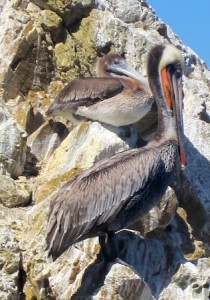By Ellen Girardeau Kempler
 Models of tactical precision, squadrons of brown pelicans have become a familiar sight in Laguna and all along the California coastline. They conduct their fish-finding missions gliding just above the waves in lines of three or more birds, or flying high with beaks pointing seaward, ready to dive at the first silvery flash of schooling anchovies, sardines, mackerel or other small fish.
Models of tactical precision, squadrons of brown pelicans have become a familiar sight in Laguna and all along the California coastline. They conduct their fish-finding missions gliding just above the waves in lines of three or more birds, or flying high with beaks pointing seaward, ready to dive at the first silvery flash of schooling anchovies, sardines, mackerel or other small fish.
Like extinct pterodactyls, brown pelicans have locking joints in their necks that allow them to plunge-dive without injury and expandable lower jaws that let them open their throat pouches to suck in fish. These shared physical features probably explain why many people think pelicans evolved from pterodactyls. Fossils show that the first pelicans appeared 60 million years after pterodactyls became extinct. Like all birds, their wings were covered with feathers, while pterodactyls’ wings had webbing. Born dive-bombers, both were built for hunting efficiency and speed.
Cruising through the sky, brown pelicans look top heavy and almost comical. Diving tranforms their awkwardness to grace, as they draw their wings into a V and drop straight into the water from as many as 100 feet above the ocean’s surface (the deeper the fish, the higher the dive). They enter with such force that they can stun fish as deep as six feet beneath the surface. In addition to the locking neck joint, air sacs throughout the pelican’s body help protect it from the impact.

Pelicans have the largest pouch of any bird. It expands like a net to hold up to three gallons of water and fish. After tipping their beaks forward to drain the water, pelicans swallow their catch whole. They can eat as much as four pounds of fish in one day.
Once pushed to the edge of extinction by DDT, brown pelicans have survived to thrive once more along California’s coast and offshore islands. Their breeding populations on the Channel Islands have increased steadily since 1980. Uniquely adapted to their ocean environment, they fly and fish as pelicans have for 30-40 million years.
The former communications director of Laguna Art Museum and Laguna Canyon Foundation, Ellen Girardeau Kempler is founder and chief navigator of Laguna-based Gold Boat Journeys. She specializes in travel planning, writing, strategic marketing and social media training. Contact her at [email protected].




